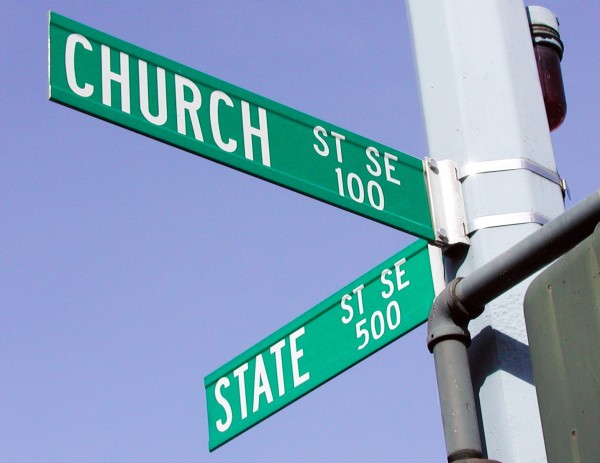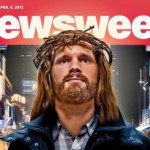The Myth of Religious Violence
by Dr. Benjamin Wiker
Filed under Christianity and Violence
One of the enduring myths of the secular state is that religion is so dangerous, so volatile, so likely to burst into conflagrations of violence, that the only protection we have from societal destruction is the erection of a wall that separates religion from the state.
We've all heard the story, and in fact, having also heard endless tales of horror about the great religious wars—especially the French Wars of Religion and the Thirty Years War—we might be strongly inclined to believe the myth.
Even my calling it a myth seems out of place. Isn't it true—in fact, a truism—that wherever religion and politics mix, it is like gasoline and a match? Isn't that what history teaches us?
No. History actually teaches us two things.
First, as William Cavanaugh so powerfully argues in his Myth of Religious Violence, when we take a closer look at the 16th and 17th century wars of religion we find that differences between Catholics and Protestants, and Protestants and other Protestants, were secondary to the aims of the emerging nation-states and various political and dynastic intrigues. Simply put, the main cause of these wars was political, not religious.
How can that be? If religious differences were the main cause of these bloody conflicts, Cavanaugh maintains, then we would expect to find that they were invariably fought along neat denominational lines. What we actually find is Catholic emperors attacking popes, Catholic French kings attacking Catholic emperors, Protestant kings and princes siding with Catholic kings against other Protestants, Lutheran and Catholic kings uniting against Catholic emperors, Protestant Huguenot nobles and Catholic nobles in France uniting against both Catholic and Protestant Huguenot commoners who likewise united against the nobles, Protestant and Catholic nobles in France uniting against their Catholic king, Protestants rejecting the Protestant Union (the coalition of German Protestant states) even while some Catholics were siding with it, Lutheran princes adamantly supporting the rights of a Catholic emperor, Catholic France supporting Protestant princes in Germany, the Dutch Calvinists helping the Catholic king to repress uprisings of French Calvinists, a Lutheran leading the Catholic imperial army, and mercenaries of every religious stripe selling themselves to the highest Catholic or Protestant bidder.
And that is only a very quick overview of the examples provided, at great length, by Cavanaugh. A careful, unbiased study of the so-called religious wars yields the rather surprising result that they were not religious wars. They were political wars that both ignored religious differences when the more important political aims demanded either cooperation with religious opponents or antagonism to those sharing the same religious beliefs, and used religious differences when they would serve political purposes.
That's the first history lesson. The second is equally important, and related to the first. As Cavanaugh makes equally clear, the secular state needed (and still needs) people to believe the story that religion is the cause of violence because this belief allows for the actual creation of the secular state. The secular state is what emerges when religion is forcibly removed from the public square through the powers of the state. The myth of religious violence justifies the removal of religion, and it is through that very removal that the state achieves secularization.
This can be seen, argues Cavanaugh, in the landmark Supreme Court case Everson v. Board of Education (1947) that interpreted the Establishment Clause as demanding (in Justice Hugo Black's words, borrowed in turn from Thomas Jefferson) the erection of "a wall of separation between church and State."
As other legal historians have shown, Jefferson's words had little or no legal effect prior to Everson. American jurisprudence was defined by the notion of cooperation between the church and state because there was general agreement that the state needed the moral and religious support provided by the church.
But by the mid-twentieth century, secularism had taken hold of the intelligentsia and, through university education, had formed the mindset of legal scholars and jurists. They were formed by the Enlightenment myth that religion was a negative presence that, for the sake of human progress, needed to be eliminated for the sake of peace. A sign of this (as everyone believed) was the horrible atrocities of the religious wars.
So it was that Justice Hugo Black, in his majority opinion, used that notion that religious violence in Europe was the defining reason why the American founders had written the First Amendment's Establishment Clause: "Congress shall make no law respecting an establishment of religion, or prohibiting the free exercise thereof;..."
As proof, Black invoked Jefferson's famous words from a letter of 1802 written to the Danbury Baptists, wherein Jefferson remarks, "I contemplate with sovereign reverence that act of the whole American people which declared that their legislature should 'make no law respecting an establishment of religion, or prohibiting the free exercise thereof,' thus building a wall of separation between Church and State." So, Black ended his opinion with the flourish: "The First Amendment has erected a wall between church and state. That wall must be kept high and impregnable."
For Black, and especially for those secular-minded justices using the reasoning of Everson thereafter, the specter of religious violence demanded the secularization of politics. So it was that, since 1947, Everson has been used to stop Bible reading and prayer in public schools, deny Christian groups access to public school and public university buildings, justify the removal of nativity scenes from public squares and Ten Commandment plaques from judicial buildings, and (unsuccessfully) to remove "In God We Trust" from coins.
In short, Everson has become an instrument for state-sanctioned secularization. It has effected the emergence of a truly secular state precisely through the active separation of the church from the state and the erection of a wall of separation. Historically, this active separation, and wall, created the secular state where one did not exist before. And I think I need to add (to capture the full irony of its use of the First Amendment's Establishment Clause), this active separation establishes a secular state, using federal power to transform America from a Judeo-Christian culture to a secular culture.
Now you see the connection between the first history lesson and the second. If the notion that religion is the main cause of bloody conflict is a myth, and the so-called religious wars were actually fueled by political ambition, then the alleged pressing need to erect an impregnable wall of separation between church and state, collapses as well. What, then, is the justification for the secularized state?
Related Posts
Note: Our goal is to cultivate serious and respectful dialogue. While it's OK to disagree—even encouraged!—any snarky, offensive, or off-topic comments will be deleted. Before commenting please read the Commenting Rules and Tips. If you're having trouble commenting, read the Commenting Instructions.













